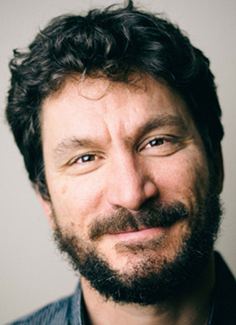Lifestyle
Copyright@ Australian Catholic University 1998-2025 | ABN 15 050 192 660 CRICOS registered provider: 00004G | PRV12008
Copyright@ Australian Catholic University 1998-2025 | ABN 15 050 192 660 CRICOS registered provider: 00004G | PRV12008

Life can be hard. Relationships break down. Accidents happen and people get hurt. We live with minor ailments or chronic illnesses, get bullied at work or at school, and struggle emotionally, financially and physically.
This causes much stress and suffering, some of which is unavoidable. Often we compound that stress by latching onto the idea that life is unfair, that things should be better. And the harder we hold on, the more we tend to suffer.
“We imagine how we’d like our lives to be, and then we cling to that idea quite strongly,” says Professor Joseph Ciarrochi, psychologist and co-author of Your Life, Your Way.
“We cling to the idea that we should always have pleasant experiences that last, or have a life that is consistently ideal, or a life with no problems or regrets. These are unrealistic expectations, and clinging to such ideas in the face of reality leads to suffering.”
So what happens when we relax this intense and ultimately futile grip on ideas and feelings?
A growing body of research suggests that the practice of 'letting go' — known in Buddhism as 'nonattachment' — may prevent some of that anguish and have a positive effect on our mental health.
Nonattachment refers to the ability to avoid the self-inflicted suffering that results from grasping or pushing away experiences – whether those experiences are positive or negative, big or small.
“Those who are nonattached can let go of unhelpful beliefs, ideas, experiences and possessions,” say Professor Ciarrochi and his colleague Dr Baljinder Sahdra, a fellow researcher at ACU’s Institute of Positive Psychology and Education (IPPE).
“People might still feel disappointment when something bad happens, when they can’t have something they want or be the centre of attention, but nonattached people don’t suffer as much because they don’t ruminate, they don’t hold resentment and they don’t demand that things be different.”
In recent decades, behavioural scientists have increasingly turned to Eastern philosophies like Buddhism for inspiration.
As a result of this growing scientific exploration, contemplative practices like meditation and mindfulness — both rooted in Buddhist thought and theory — have moved into the mainstream.
While the evidence backing the positive effects of mindfulness is vast and encouraging, the related concept of nonattachment is a relative newcomer in the psychological literature.
Professor Ciarrochi and Dr Sahdra have sought to change this, undertaking several studies exploring the effects of nonattachment on both adolescents and adults.
Their most recent paper, a long-term study involving almost 2,400 students in 16 Australian high schools, found that nonattachment reliably predicted improvements in the mental health of students in their last three years of school.
The researchers found great variation in the way individual students were able to avoid becoming attached to feelings and experiences.
“Those who were more willing to let go and move on were certainly better off in terms of developing positive mental health,” Professor Ciarrochi says.
He and his co-author Dr Sahdra, a prominent mindfulness researcher, argue this finding “suggests practical benefits of promoting nonattachment in high school”.
They propose that the teaching of nonattachment could be coupled with mindfulness lessons, which are increasingly common in Australian schools. The first national mindfulness curriculum, which is linked with the not-for-profit Smiling Mind app, was launched in 2018.

“I think mindfulness is the precursor to nonattachment, and so we could expand on those lessons and specifically encourage students to notice when they’re clinging onto ideas about how people and life must be,” says Professor Ciarrochi, who co-authored Get Out of Your Mind and Into Your Life for Teens.
“You need to be able to notice when you’re engaging in wishful thinking, like expecting life to always be stress-free and fair. Nonattachment involves letting go of wishful thinking and seeing life as it is. When we do this, we are in the best position to improve life.”
The IPPE research was the first longitudinal study of its type to explore the impact of nonattachment on adolescents.
It built on several previous studies by ACU researchers showing that nonattached adults tend to be “better at managing time, handling social situations, achieving important goals [and] flexibly adapting to situations by changing their points of view in the face of contradictory evidence”.
Professor Ciarrochi and his colleagues have also conducted research showing that nonattachment is as effective as empathy — generally regarded as the benchmark variable associated with pro-social behaviour – at promoting kindness and other altruistic behaviours.
This challenges the common misconception that nonattachment means you cease being “attached” to people, or that you avoid closeness with others. In fact, says Professor Ciarrochi, “nonattached people tend to connect with others better than attached people, and have better friendships”.
“Nonattached people don’t have unrealistic ideas about friendship. They don’t insist on having a perfect friend who always thinks of them, always has their best interests at heart and never makes a mistake, because in reality there’s no such friend – it’s a robot friend,” he says.
“When a friend makes a mistake or does something to upset a nonattached person, they can speak to them about it and then let it go. They tend to be better friends because they can let go of the small stuff.”
People who avoid clinging to positive feelings of self-enhancement can also make better friends, Professor Ciarrochi says, because they find it easier to step away from the spotlight.
“It’s a really important skill to be able to let our friends shine, and often that means letting go of our own positive feelings for the benefit of someone else. It allows us to build stronger relationships and help others, so our friendships are better, and society benefits, too.”
Another common misconception is that nonattachment means you’re mentally detached; that you care less about worldly concerns. This is again a misunderstanding, says Professor Ciarrochi. He draws on the pandemic as an example.
“An example of attachment would be to fall into despair, to insist that life be like it was before the pandemic, or to put your head in the sand and label the virus a hoax … all of these things are examples of clinging to unrealistic ideas,” he says.
On the other hand, research shows a nonattached person “genuinely cares about, is engaged in and responsive to the present situation without falling into self-aggrandisement or self-degradation”.
“They are concerned about the suffering the pandemic has caused, but they’re also realistic about it — they do what they can to fight the virus while letting go of the idea that it should be different,” Professor Ciarrochi adds.
“If we’re able to accept the situation for what it is, then we might find things that are beautiful, wondrous and lovely amidst a pandemic: being present and appreciating those pleasant moments in a day, the friendships we have, while always remaining present and honest about the threats to our health.”
So how does one begin to practice nonattachment, or to encourage others to do so?
Well, simply telling yourself or your friend to “just let it go” is unlikely to work.
In Buddhist theory, an attachment to beliefs, sensations, physical objects or even life itself is related to “one’s mistaken view of reality as fixed or permanent”.
This can be countered by nurturing insight into the ever-changing and impermanent nature of reality.
“Such insights often occur in formal meditation training, but can also occur in daily life,” say Professor Ciarrochi and his co-authors, in research exploring the relationship between nonattachment and mindfulness.
“For instance, ups and downs in one’s career, damage to or decay of cherished physical possessions, death of a family member, personal injury or illness are myriad life lessons in nonattachment, opportunities to learn to ‘let go’ of one’s clinging to cherished ideas …”
Often the first step is acknowledging that you have a choice to avoid hanging on. Then you need make a conscious effort to notice when you’re grasping to something, in order to practice letting go.
A regular mindfulness practice is also a handy tool for achieving nonattachment.
“It’s a very useful intervention in helping people to let go, and I think it’s just a matter of noticing what your mind naturally wanders to – whether it’s someone who has upset you, or some worry about the future,” Professor Ciarrochi says.
“You might find that your mind deliberately goes to that place, even if it’s unpleasant, and you go there because you want your mind to somehow magically fix the perceived problem.
“This rumination just makes things worse. The goal of nonattachment is to acknowledge that the mind can’t fix everything. Nonattachment is about recognising when you’re spinning your mental wheels, and letting go of your mental efforts so you don’t add to your suffering.”
Professor Ciarrochi hastens to add that practicing nonattachment is not a ticket to a life free of problems, worry and disappointment; rather, it’s an acceptance that these things are a part of life.
“Some things in life just kind of suck, and when life sucks, it’s okay to feel that discomfort or disappointment,” he says.
“Nonattachment is about acceptance, it’s about letting go of the way you think life should be. Once we can do that, we can be in the present moment and appreciate life for what it is, and we can see that it all fits together in one big, complex picture of pleasant and unpleasant, good and bad.”
Professor Joseph Ciarrochi is with the Institute for Positive Psychology at ACU. He is a best-selling author and acclaimed researcher who has published many books, including The Thriving Adolescent with Louise Hayes. His research interests include identifying character strengths that promote social, emotional, physical wellbeing and peak performance.

Copyright@ Australian Catholic University 1998-2025 | ABN 15 050 192 660 CRICOS registered provider: 00004G | PRV12008